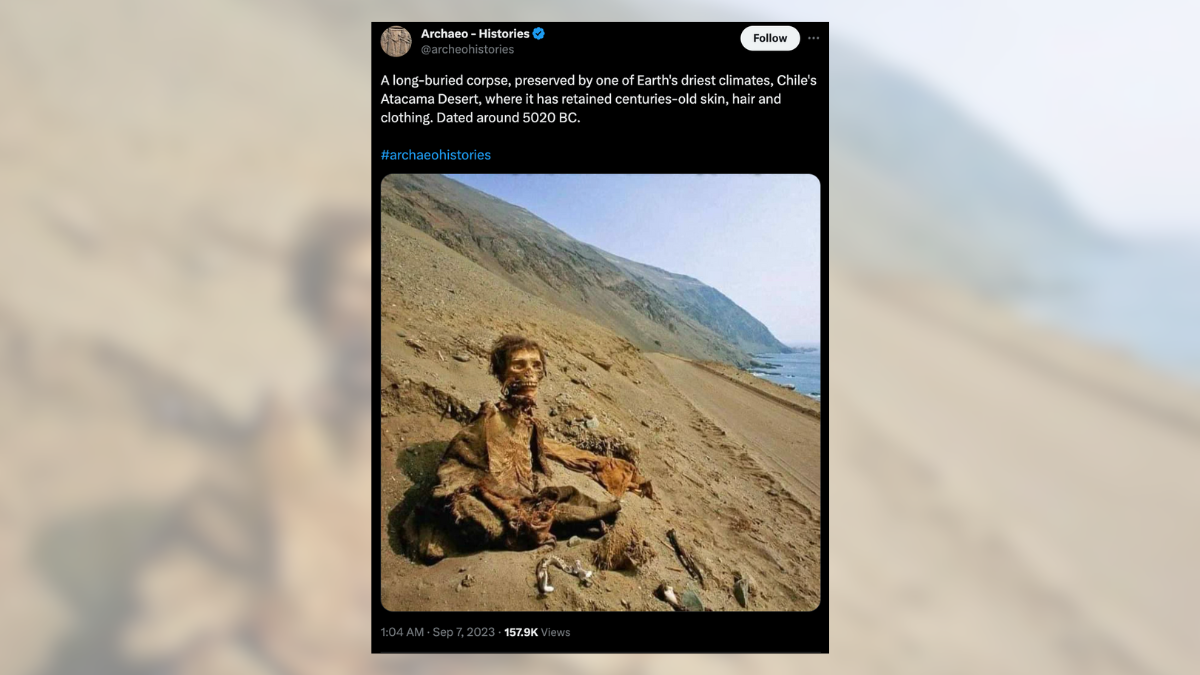Fact Check: Remarkable Pic Shows 7,000-Year-Old Preserved Human Corpse?

Claim:
A photograph authentically shows a corpse that had been preserved in Chile’s Atacama Desert since 5020 B.C.E. Remnants of hair, skin and clothing were still intact at the time the photo was taken.
Rating:
Seated in an apparent cross-legged position were the preserved, 7,000-year-old remains of a person discovered in the 21st century with skin, hair, and fragments of clothing still intact. At least, that's according to a widely circulated photo shared on X on Sept. 7, 2023, that, at the time of publication, had received more than 157,000 views:
A long-buried corpse, preserved by one of Earth's driest climates, Chile's Atacama Desert, where it has retained centuries-old skin, hair and clothing. Dated around 5020 BC.#archaeohistories pic.twitter.com/RKiybKWruH
— Archaeo - Histories (@archeohistories) September 7, 2023
As eerie as it appeared, both the photograph and the corpse it documented were authentic.
Snopes determined through a reverse-image search that the above post was a screenshot of a photo shared to Reddit on Feb. 8, 2023. A further investigation of the same reverse image search revealed that the photograph was authentic and published by National Geographic on Aug. 14, 2012 (archived here). Information that accompanied the photograph read:
NATURAL WONDER
Preserved by one of Earth's driest climates, a long-buried corpse in Chile's Atacama Desert retains centuries-old skin, hair, and clothing (file picture).
Naturally dehydrated corpses like this probably inspired the region's ancient Chinchorro people to actively mummify their dead, scientists speculate in a new study. The practice, researchers suggest, took off during a time of natural plenty and population growth, when the Chinchorro were better able to innovate and develop culturally.
Living in fishing villages along the coasts of Chile and Peru, the Chinchorro had begun mummifying skeletons by 5050 B.C., thousands of years before the Egyptians. Archaeologists have long wondered how the practice—and a related cult of death—arose, with some speculating it had been imported from the notably wetter Amazon Basin (regional map).
"Our study is one of the few to document the emergence of social complexity due to environmental change"—in this case, climate shifts that desiccated the Atacama, study leader Pablo Marquet said.
"Until now, most of the emphasis has been on how environmental change triggers the collapse of societies," said Marquet, an archaeologist at Catholic University in Santiago, Chile.
(Read more about the Chinchorro mummies in National Geographic magazine.)
—Ker Than
Submitted as a UNESCO World Heritage Site in 1998, the Atacama's human ties date back to at least 10,000 B.C.E. One such group were the Chinchorro people, an ancient South American hunter-gatherer group known to have "walked in the land of the dead." Across Chile's Atacama Desert, thousands of shallow graves encapsulated humans, images of whom would later permeate the internet due to their still-preserved, and in some instances alien-like, characteristics.
This unique preservation is made possible by the environmental characteristics of the Atacama Desert, a desert plateau that stretches east from South America's Pacific coast to the Andes Mountains, encompassing an area roughly 49,000 square miles. It is considered the world's driest nonpolar desert, which has created an environment that is hostile, yet ripe for preserving bodies.
Sources:
Centre, UNESCO World Heritage. "San Pedro de Atacama." UNESCO World Heritage Centre, https://whc.unesco.org/en/tentativelists/1191/. Accessed 15 Sept. 2023.
Evon, Dan. "Snopes Tips: A Guide To Performing Reverse Image Searches." Snopes, 22 Mar. 2022, https://www.snopes.com/articles/400681/how-to-perform-reverse-image-searches/.
Greicius, Tony. "Detecting Life in the Ultra-dry Atacama Desert." NASA, 20 Apr. 2017, http://www.nasa.gov/feature/jpl/detecting-life-in-the-driest-place-on-earth.
"Https://Twitter.Com/Archeohistories/Status/1699679970824774074." X (Formerly Twitter), https://twitter.com/archeohistories/status/1699679970824774074. Accessed 15 Sept. 2023.
"National Geographic Magazine." National Geographic, https://www.nationalgeographic.com/magazine. Accessed 15 Sept. 2023.
Nolan, Garry, and Atul Butte. "The Atacama Skeleton." Genome Research, vol. 28, no. 5, May 2018, pp. 607–08. PubMed Central, https://doi.org/10.1101/gr.237834.118.
"Pictures: Death-Cult Mummies Inspired by Desert Conditions?" Science, 14 Aug. 2012, https://www.nationalgeographic.com/science/article/120813-mummies-chinchorro-proceedings-desert-driest-chile.
"---." Science, 14 Aug. 2012, https://www.nationalgeographic.com/science/article/120813-mummies-chinchorro-proceedings-desert-driest-chile.
Sanetosane. "A Long-Buried Corpse, Preserved by One of Earth's Driest Climates, Chile's Atacama Desert, Where It Has Retained Centuries-Old Skin, Hair and Clothing. Dated around 5020 BC." R/Archeologyworld, 8 Feb. 2023, www.reddit.com/r/archeologyworld/comments/10wigxj/a_longburied_corpse_preserved_by_one_of_earths/.
"The Edge of Habitability: Tracking Water in the World's Driest Desert." ASU News, 2 Nov. 2022, https://news.asu.edu/20221031-edge-habitability-tracking-water-worlds-driest-desert.
Travel, Chile. "North and the Atacama Desert." Chile Travel, https://www.chile.travel/en/where-to-go/macrozone/north-and-the-atacama-desert/. Accessed 15 Sept. 2023.
"Why Is The Atacama Skeleton So Controversial?" IFLScience, 20 Jan. 2023, https://www.iflscience.com/why-is-the-atacama-skeleton-so-controversial-67200.
Wright, John W. The New York Times 2006 Almanac. New York, N.Y. : Penguin Reference, 2006. Internet Archive, http://archive.org/details/newyorktimes200600wrig.

 Yahoo News
Yahoo News 

